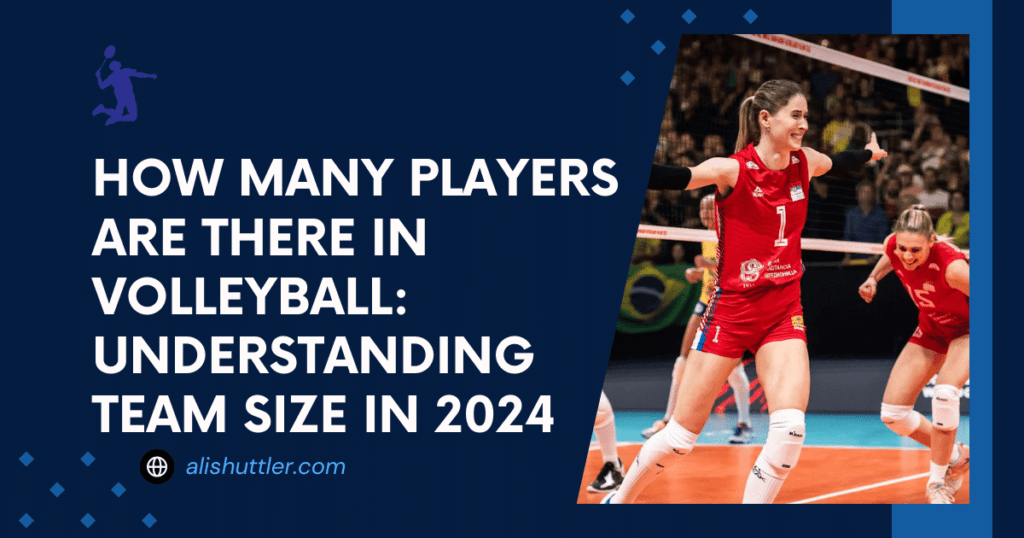Ever wondered how many players are on a volleyball team? Whether you’re new to the game or just curious, understanding the dynamics of this popular sport, gameplay, and different player specializations is essential. From court positions to teamwork strategies, knowing the number of players involved can provide valuable insights into the game’s fast-paced and dynamic nature.
Table of Contents
Understanding the Standard Volleyball Team Size
Indoor Volleyball Team Size
Indoor volleyball teams consist of 6 players on the court at a time. Each team is allowed to have additional players on the roster for substitutions during matches.
Volleyball teams strategically position their players to ensure that each individual contributes effectively to the game. There are specific roles and positions such as setter, outside hitter, middle blocker, opposite hitter, and libero in team sports.
The setter’s main role is to orchestrate the offense by setting up attackers for kills. The outside hitter specializes in attacking from the front-left position while also playing an essential defensive role. Middle blockers aim to block opponents’ attacks at the net and contribute offensively with quick sets in coordination with setters.
Opposite hitters focus on strong hitting from the right side of the court and play a significant blocking role as well. Lastly, liberos specialize in defensive skills, especially receiving serves and making digs.
Roster Substitutions
Teams often utilize their additional roster members for strategic substitutions based on skill sets or tactical adjustments during sports matches. For example, if a team needs more offensive power or better defense in certain situations against the opponent, they can make substitutions accordingly.

Volleyball teams must have versatile substitutes who can seamlessly integrate into different positions when needed. This ensures that there’s no drop-off in performance when substitutions occur.
The Role of the Libero in Volleyball Dynamics
Specialized Defensive Player
In volleyball, there are six players on each side of the court. However, one player has a unique role – the libero. This specialized defensive player is crucial for enhancing a team’s defense and ball control. The libero wears a different color jersey to distinguish themselves from other players and follows specific substitution rules.
The libero plays an essential role in keeping rallies alive by making spectacular digs, receiving powerful serves, and playing the ball near the net from the opposing team. Because they are not allowed to serve, spike, or attempt to block, their primary focus is on defending against the opponent’s attacks and setting up scoring opportunities for their teammates.
Unique Substitution Rules
The presence of a libero allows teams to make unlimited substitutions involving this player without prior notification to the referee during stoppages in play. This flexibility enables coaches to strategically rotate players based on their skills and strengths without disrupting the flow of the game.
Moreover, due to their defensive prowess and agility, liberos often excel at reading opponents’ offensive strategies and adjusting positioning accordingly. Their quick reflexes enable them to cover large areas of the court efficiently while maintaining composure under pressure.
Overview of Volleyball Scoring System and Player Impact
Impact of Rally Scoring
Rally scoring in volleyball is a system where points are scored on every serve, regardless of which team served. This means that every play and every touch on the ball matters for scoring. For example, if a team serves the ball and wins the rally, they score a point; if they lose the rally, their opponents earn a point.
Players rotate positions as their team wins the serve in volleyball. This rotation ensures that each player gets an opportunity to serve the ball from the back row and play at the net from the front row. As such, each player’s performance directly impacts their team’s ability to maintain possession of the ball and ultimately score points.
Individual Player Impact
In volleyball, individual players have specific roles that contribute to their team’s success during rallies. The setter coordinates offensive plays by positioning themselves close to the net to set up attackers for hits or blocks. Hitters (or spikers) aim to score points by hitting or spiking the ball over the net into their opponent’s court, while liberos specialize in defensive skills like digging and passing.
The impact of each player is crucial because successful execution of these roles can lead to scoring opportunities through effective attacks or defensive stops against opponents’ attempts.
History and Evolution of Volleyball Player Numbers
Original Design: 9 Players per Team
Volleyball, in its original form, featured nine players on each team. This setup required a different set of strategies and gameplay dynamics compared to the modern six-player format. With more players on the court, teams had to focus on coordinating their movements effectively to cover the larger playing area and the ball.

The transition from nine to six players per team marked a significant shift in volleyball’s gameplay structure. As such, it is essential to understand how this change impacted not only the number of players but also the overall strategy employed by teams during matches.
Influence on Gameplay Strategies
The adoption of the standard six-player format in 1916 revolutionized volleyball tactics. With fewer players covering the same court area, individual responsibilities became more defined, leading to specialized positions such as setters, hitters, and liberos. This shift allowed for more precise plays and strategic formations tailored to exploit opponents’ weaknesses.
Furthermore, changes in player numbers have continually influenced coaching methodologies and training regimens. Coaches now emphasize agility, quick decision-making skills, and versatile player capabilities due to reduced manpower on the court.
Variations in Volleyball: Beach and Sitting Rules
Beach Volleyball Teams
Beach volleyball teams consist of 2 players per side, making it a dynamic and fast-paced variation of the sport. With only two players on each team, the game demands quick reflexes, precise communication, and exceptional teamwork. The smaller team size allows for more strategic plays and intense one-on-one matchups between opponents.
In beach volleyball, the court position is crucial as only two players are covering the entire area. This means that each player must be proficient in both offensive and defensive skills to ensure effective coverage of the court. The smaller team size also results in more direct involvement for each player throughout the match.
Sitting Volleyball
Sitting volleyball is specifically designed for athletes with physical disabilities who may find it challenging to play standing volleyball. Unlike traditional volleyball, sitting volleyball has modified rules to accommodate different playing environments. It emphasizes agility, precision, and adaptability as players move around the court while remaining seated.
In this variation of volleyball, athletes are positioned differently due to their seating arrangement on the court. The back rows take on an essential role in setting up plays, defending against opponents’ attacks, and controlling the ball. Despite these modifications, sitting volleyball retains many fundamental elements of traditional volleyball while providing an inclusive platform for athletes with physical impairments.
Strategies for Team Play and Formation Utilization
Formations in Volleyball
Volleyball teams can use different player specializations to optimize their strengths, often employing formations like 6-2 or 5-1. In a 6-2 formation, there are six-row players and two who can serve. Conversely, a 5-1 formation involves five-row players, one designated server, and a ball.
Teams adjust their formations based on the opposing team’s strengths and the ball to gain an advantage. For instance, if the opposing team has strong blockers at the net, a team might opt for a 6-2 formation to increase attacking options.
Communication and Coordination
Effective communication among team members is crucial in volleyball gameplay. Players need to communicate constantly during games to ensure proper positioning and execution of specific techniques and the ball. Coordination between teammates ensures that everyone is aware of each other’s movements and actions.
Players must work together seamlessly; they should be able to anticipate each other’s moves without needing explicit instructions during fast-paced plays.
Essential Volleyball Skills for Team Success
Fundamental Skills for Team Success
Volleyball is a team sport that requires a combination of essential skills for success. Serving, passing, setting, attacking, and blocking the ball is crucial to the game. When each player masters these skills, it enhances the team’s overall performance.
Defensive skills such as digging and diving also play a significant role in contributing to the team’s success during a volleyball match. A well-rounded team with strong individual defensive capabilities can effectively counter their opponent’s offensive strategies.
Developing strong individual skills not only benefits the players but also contributes to the collective ability of the entire team. For example, an outside hitter needs to have exceptional attacking abilities to score points for their team during a volleyball match.
Players who excel at serving can gain an advantage by putting pressure on their opponents with powerful serves and a well-placed ball. This skill is critical in gaining points and maintaining control of the game throughout a competitive set or match.
The Role of Each Player
In volleyball, there are six players on each side of the net – three in front and three at the back. Each player has specific roles based on their position: setter, outside hitter, middle blocker, opposite hitter (right-side hitter), libero/defensive specialist, and defensive setter.
The setters are responsible for creating opportunities for attackers by setting up good balls while attackers focus on scoring points through powerful hits or spikes. Liberos specialize in defensive plays including digging and receiving serves while providing stability to their teams’ defense.
Recognizing Common Misconducts Affecting Player Count
Impact of Violations
Violations such as illegal substitutions can significantly impact the number of players in a volleyball game. When a player makes an unauthorized substitution, it can lead to confusion about who should be on the court, resulting in either too many or too few players participating at any given time. This not only disrupts the flow of the game but also affects the fairness and integrity of play.
Unsportsmanlike conduct is another violation that can directly affect player count. If a player engages in behavior deemed unsportsmanlike by officials, they may receive penalties such as yellow or red cards. These penalties could result in temporary or permanent removal from the game, thereby reducing the number of available players for their team.
Ensuring Fair Play and Consistent Numbers
Adhering to rules and maintaining sportsmanship is crucial for ensuring consistent player numbers throughout a volleyball match. By following regulations set forth by governing bodies like FIVB (Fédération Internationale de Volleyball), teams can avoid unnecessary penalties that might lead to forfeiting points or even matches due to insufficient player availability.
How Many Players Are There in Volleyball: Summary
You’ve now gained a comprehensive understanding of volleyball player numbers, from the standard team size to the unique roles and strategies that shape the game. As you continue to explore the world of volleyball, remember that each player’s impact extends beyond mere numbers on the court. Embrace the dynamics, skills, and teamwork involved in this exhilarating sport. Whether you’re a player, coach, or enthusiast, keep honing your skills and deepening your knowledge to elevate the game for yourself and those around you.

So, go ahead and hit the courts with a newfound appreciation for the intricacies of volleyball. Keep practicing, learning, and sharing your passion for the game and ball. The more you delve into its depths, the more you’ll uncover its richness and excitement. Happy playing!
Frequently Asked Questions
How many players are there in a standard volleyball team?
A standard volleyball team consists of six players on the court at a time. Each team typically has three front-row players and three back-row players, with specific rotations and positions to follow during play.
What is the role of the Libero in volleyball?
The Libero is a specialized defensive player who wears a different color jersey and has unique rules, such as not being allowed to serve, attacking above net height when in front zone, or being set from an overhead position. Their primary role is to excel in passing the ball and defense.
Are there any variations in player numbers for beach volleyball and sitting volleyball?
Yes, both beach volleyball and sitting volleyball have different player numbers compared to traditional indoor volleyball. Beach volleyball teams consist of two players per side, while sitting volleyball teams have six players but with specific rules for seated play.
What are some essential skills for success as a volleyball player?
The key skills include serving (overhand, underhand), passing (forearm pass), setting (overhead pass), attacking/hitting (spiking), blocking, and digging. Agility, teamwork, communication, and strategic thinking contribute significantly to individual and team success.
Can misconduct affect the number of players on the court during a game?
Yes! Common misconducts such as illegal substitutions or unsportsmanlike conduct can lead to penalties resulting in fewer active players on the court. All players must adhere to the rules governing their conduct during matches.

